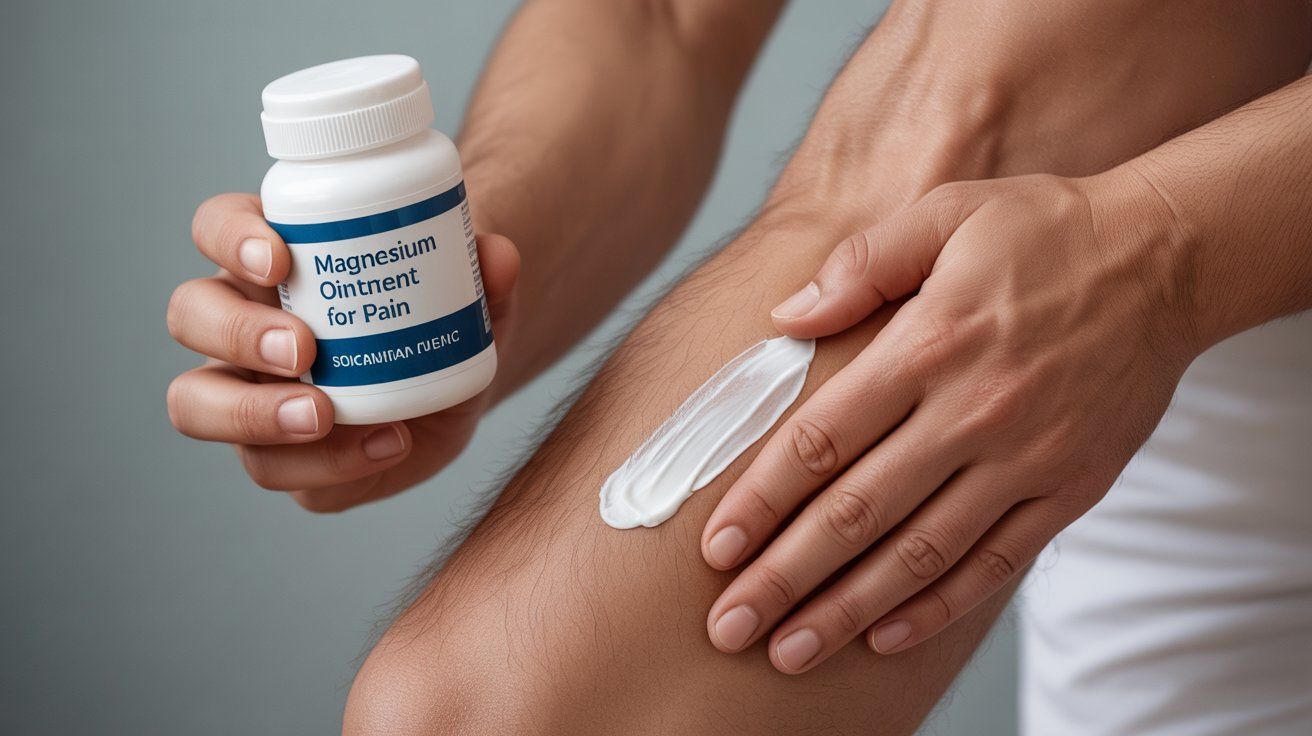Magnesium ointment for pain may ease muscle soreness, joint stiffness, and cramps. Safe, easy to apply, but absorption and evidence remain mixed.
Magnesium ointment for pain
Magnesium ointment for pain is gaining attention as a natural option for muscle soreness, joint stiffness, and chronic discomfort.
Unlike oral supplements, topical magnesium is applied directly to painful areas, aiming for localized relief.
While research debates skin absorption, many users report comfort and recovery benefits, making it a promising addition to pain management routines.

What Is Magnesium Ointment for Pain?
Magnesium ointment for pain is a topical preparation made with magnesium salts, often magnesium chloride, blended into a thick base.
Unlike magnesium oil, sprays, or creams, ointments stay longer on the skin, allowing gradual absorption. They are applied directly to sore muscles, joints, or the lower back for targeted relief.
This localized approach aims to reduce discomfort without the digestive side effects linked to high-dose oral supplements.
Benefits & Advantages
| Benefit | Explanation |
|---|---|
| Localized relief | Targets sore muscles and joints directly, avoiding the whole digestive system. |
| Gentle on digestion | Unlike oral magnesium supplements, it does not cause stomach upset. |
| Muscle & joint support | Helpful for muscle soreness, arthritis stiffness, and post-exercise recovery. |
| Easy application | Simple to massage into problem areas, providing quick comfort. |
| Natural soothing effect | Many users find it calming and relaxing for everyday aches. |
| Consistent use benefits | May help reduce spasms, improve comfort, and support relaxation when used regularly. |
How Magnesium May Reduce Pain
Magnesium ointment for pain may help by calming nerve signals, relaxing muscles, and reducing spasms. Magnesium is known to block NMDA receptors, which are linked to pain sensitivity.
When applied topically, it may ease localized muscle soreness, joint stiffness, and post-exercise discomfort. By supporting natural relaxation pathways, magnesium ointment offers a non-drug option that some users find beneficial for everyday aches and chronic pain conditions.
Does Topical Magnesium Absorb Through Skin?
A common question is whether magnesium ointment for pain truly absorbs through the skin. Research shows mixed results: some studies suggest limited dermal absorption, while others note measurable increases in magnesium levels after topical use.
What’s certain is that many users report reduced soreness and stiffness. Even if absorption is modest, the soothing effect of massage and application itself may provide pain relief benefits.

Evidence: Clinical Studies on Magnesium Ointment for Pain
Scientific evidence for magnesium ointment for pain is limited but growing. Small trials suggest benefits for fibromyalgia, muscle cramps, and post-surgical discomfort, though results vary.
Some studies found no significant absorption through skin, while others reported improved symptoms after regular use. Anecdotal reports often highlight relief for sore joints and muscles.
More large-scale, controlled studies are needed to confirm its true effectiveness in pain management.
Risks, Side Effects & Limitations
Magnesium ointment for pain is generally safe, but some users may experience skin irritation, itching, or redness.
Research shows inconsistent absorption, meaning not everyone gains the same results. It should not replace prescribed treatments for chronic conditions like arthritis or neuropathy.
People with kidney disease or sensitive skin should consult a healthcare professional. The main limitation is the lack of large, high-quality clinical trials confirming long-term effectiveness.

FAQs
Q1: Does magnesium ointment for pain really work?
A: Some users report relief for muscle and joint pain, but clinical evidence is mixed. It may help certain people, especially for localized pain relief.
Q2: How long does it take for magnesium ointment to work?
A: Many feel a soothing effect within minutes, but consistent use over days may be needed for chronic conditions.
Q3: Can magnesium ointment replace oral supplements?
A: No. While topical magnesium may provide local relief, it doesn’t significantly raise blood magnesium levels. Oral forms remain better for systemic needs.
Q4: Is magnesium ointment safe for everyone?
A: Generally safe, but avoid use on broken skin. People with kidney disease or severe medical conditions should consult a doctor first.
Q5: Which is better – magnesium ointment, cream, or spray?
A: They work similarly. Magnesium ointment is thicker and stays longer, while sprays and creams absorb faster.

Hamid Raza, aged 65, is a seasoned expert in nutrition, health supplements, and wellness, with over four decades of experience researching and educating people about essential minerals like magnesium. His work focuses on helping individuals improve energy, bone health, muscle function, and overall wellness through scientifically-backed magnesium knowledge.
Throughout his career, Hamid has contributed to numerous health articles, research studies, and wellness blogs, making complex nutritional science accessible to everyday readers. Passionate about natural health solutions, he guides readers on choosing the right magnesium supplements for optimal health.





